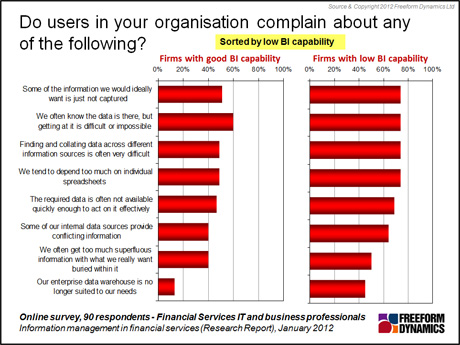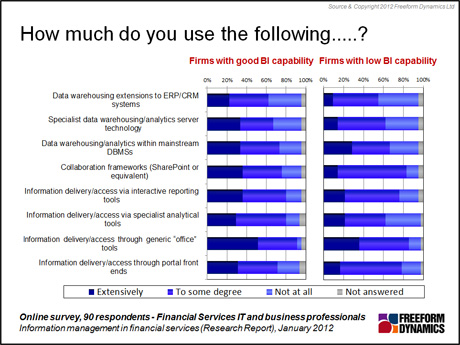Obtaining budget for new technology investments can be a difficult exercise at the best of times. So how can companies make the business case for investing in their information management systems? Equally importantly, how can companies avoid getting into a vicious circle of failed projects followed by underinvestment, all the while accompanied by high levels of dissatisfaction on the part of business professionals?
Some of the answers to these questions can be found in the results from an online survey we conducted in late 2011. In this survey, we asked financial services IT and business professionals about their priorities, challenges and successes when it comes to meeting the information needs of the business. While the survey itself was focused on a specific industry sector, the lessons that can be learnt are much more widely applicable.
Information management remains one of the most challenging areas for any business to address. However, it is clear from the responses we received that there are companies which are doing a lot better at tackling the challenge than others. As can be seen in Figure 1, companies with greater business intelligence (BI) capabilities have made better progress at improving data capture and access, have done more to resolve data conflicts, and are better at storing the right data.

Figure 1
Technology is an essential element helping companies have greater success at making sure that the right people can access the right information at the right time. And indeed, companies with better BI capabilities are using technology more intensively than those who are struggling with information provision (Figure 2).

Figure 2
Furthermore, firms with good BI capabilities are twice as likely to significantly improve the provision of BI during the next 12 – 18 months than those who are doing less well. In short, firms who are doing better are in a virtuous circle where investment in BI has delivered benefits, which in turn gives them the confidence to invest more.
However, simply buying more technology isn’t going to solve the issue. Many of the areas in which firms with better BI capabilities have made more progress require a closer and/or better relationship between IT and the business. Otherwise, how would IT know which additional data to capture, which data to collate, and which data set is the ‘truth’, to mention just a few examples.
But while essential, even that isn’t enough: Unless fundamental organisational issues and barriers are also addressed, business complaints about having the right data at the right time are likely to remain high, or increase again. Barriers to successful information management include – but aren’t limited to – functional and departmental silos, process inefficiencies, data ownership issues, and disagreements about budget allocation.
When we looked at what sets apart the organisations who have risen to the challenge more successfully there is a strong correlation between company culture and the way the business is run, and information management success (Figure 3).

Figure 3
So where to start? Ultimately it will depend on the specific circumstances of each individual business. But there are fundamentals that shouldn’t be ignored: IT can’t go it alone – the business needs to do its part as well. All the barriers mentioned above are business issues, even though IT often gets the blame for many of the problems that arise as a result, or is told to sort something out that technology on its own can’t solve.
The starting point to improved information management hence needs to have two key aspects: one, a will on the part of the business to address the barriers outlined earlier in this article; two, a recognition that IT needs to be an equal partner. Once the process to remove obstacles has started, the next step should be to look for quick wins, in particular ones that involve leveraging technologies already in use, or licensed by, the company. This approach keeps costs to a minimum while demonstrating that technology can help support more efficient processes or improved decision making. When that point has been reached, it typically becomes a lot easier to enter into the discussion about increasing technology investment.
Interested in reading the full report? It’s available here for free download.
CLICK HERE TO VIEW ORIGINAL PUBLISHED ON

Through our research and insights, we help bridge the gap between technology buyers and sellers.





Have You Read This?
From Barcode Scanning to Smart Data Capture
Beyond the Barcode: Smart Data Capture
The Evolving Role of Converged Infrastructure in Modern IT
Evaluating the Potential of Hyper-Converged Storage
Kubernetes as an enterprise multi-cloud enabler
A CX perspective on the Contact Centre
Automation of SAP Master Data Management
Tackling the software skills crunch